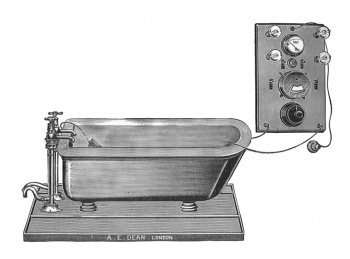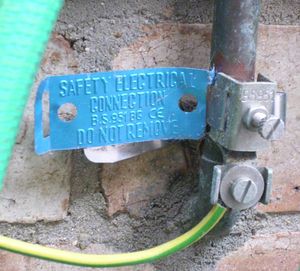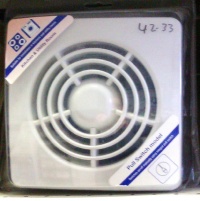Bathroom electrics
There are extra considerations for electrical wiring in a bathroom.
Why are bathrooms special?
In a bath or shower room you may be wet, naked, and barefoot. These factors can lower your skin's electrical resistance, and also mean you have a better connection to an electrical earth due to absence of any electrical insulation we normally get from our clothing. The result is that any electrical shock could have far more serious consequences - large electrical currents could flow through you to earth.
Hence there are a number of additional measures and precautions that come into play where electrical installations are located in places such as these where users are at a higher than normal risk of injury or death from the effects of electric shock.
One should also keep in mind (if you are resident in England, or Wales) that a room containing a bath or shower is classed under Part P of the building regulations as a "special location". This means that other than like for like changes of accessories etc, or the installation / upgrading of supplementary bonding, nearly all electrical work will be classed as a "Notifiable Work" for the purposes of part P. Hence to comply with the requirements the work should be carried out under a building notice, completed by a person who is a member of one of the various part P competent persons schemes, or tested and inspected by an approved part P third party tester.
What is a "bathroom"
Bath and shower rooms are one such example of these special locations. Others include:
- Wetrooms
- Swimming pool areas
- Saunas
- Steam rooms
Note that there are also some locations that may place water and electricity in close proximity, which are not considered to pose special risks. This include:
- Toilets
- Cloakrooms
- Rooms containing just a sink or basin, but no shower or bath
Finally you have Kitchens which have their own particular risks - but the requirements are subtly different from bathrooms.
Zones
Bathrooms are divided into zones for electrical purposes. Here's a diagram of them.
Zone 0
- The interior of the bath or shower
- Electrical appliances here must be IPX7
- Electrical appliances here must run on SELV at a maximum of 12v ac or 30v dc
Zone 1
- area directly above zone 0, upto a height of 2.25m above the bath or shower, or to the height of the maximum reach of the shower head if that is greater.
- Electrical appliances must be SELV with the transformer outside all the zones (subject to some exceptions - see under Extractor Fans below)
- Electrical appliances must be IPX4 or better (IPX5 or better if at risk of spray - eg from a shower)
Zone 2
- area beyond zones 0&1, extends 60cm horizontally and upto 2.25m vertically beyond zones 0&1.
- Electrical appliances must be IPX4 or better
- Electrical appliances here must run on SELV wth transformer outside the zones
Zone 3
- zone 3 ceased to exist in 2008 with the 17th edition of the wiring regs.
Outside the Zones
- Outside zone 2
- Under the bath if a tool is required to gain access
- Shaver units permitted
- SELV appliances permitted
- Non-selv portable appliances in bathrooms must be physically prevented from entering zone 2. This is usually done by limiting mains lead length on the appliance.
Supplementary bonding
Unless an installation complies with the latest requirements of the 17th edition (i.e. all required main equipotential bonding is installed, and additional protection for all circuits used in the bath / shower room is provided by a RCD with trip current of 30mA or less) then supplementary equipotential bonding is also required in the bathroom.
Note also that when making any changes to an electrical system, one must also ensure that the main equipotential bonding is brought up to current requirements.
See Earthing and Bonding for more detail.
Electrical Equipment in bathrooms
One fundamental requirement for any electrical equipment (be it an appliance or an accessory such as a switch) is that it should be suitable for the location. This means one needs to apply some common sense when choosing and installing equipment.
Unsuitable in all zones
- Some appliances are marked unsuitable for bathrooms
- Some appliances are not thus marked, but are still unsuitable. CRT TVs are one example.
Switches
Ordinary electrical light switches are sometimes permitted in a bathroom, however one should only use them where there is no possibility that someone could operate them from the bath or shower. They also should not be in locations where they are likely to get splashed or have excess steam or vapour directed at them. Traditionally, pull switches are used to mitigate some of these risks. Common alternatives include using conventional switches located outside of the room.
Switches will also be required for other devices like heaters or towel rails. Some may be intended for day to day use (i.e. "functional switching"), other may only be required just for isolation when carrying out maintenance. Again, the type of switch selected will depend on where it is going, as well as when you anticipate it being used.
Lighting
Note that the above zone concepts also apply to lighting in a bathroom. Hence in many cases lighting will need to be specifically designed for the location and be IPX4 rated or better. Lights placed in shower enclosures and directly over baths in rooms with low ceilings will need to be SELV and IPX6 or better. In larger bathrooms where lighting can be installed outside the zones then one still needs to use common sense in the selection of fittings. Although conventional mains lamp fittings may be appropriate in large rooms where there is little steam generated (typically those with no shower), they would be a poor choice in many cases.
Illuminated mirrors are often be placed direct;y above a basin, and in a bathroom this may count as zone 2 (unless the light fitting is at least 60cm clear of the taps). If this is the case, ensure that the lamp fitting is IPX4 and SELV.
Sockets
Historically, 13A general purpose mains sockets have not been permitted in bathrooms at all. The 17th edition has introduced a slight relaxation of this, but it will only apply for very large bathrooms since it permits a socket to be installed as long as it is at least 3m from the outer edge of zone 2.
Shaver sockets are permitted in zone 2, but only if they are of the isolating type with integral transformer.
(Installing a general purpose socket actually in a shower is verging on the suicidal, but remarkably, it has been done!)
Spurs / Cable connection units
Electrical equipment in a bathroom will generally need to be via a permanent "hard wired" connection. Typically to a cable outlet unit (switched or otherwise), or a fused spur unit (again, switched or otherwise). If an electrical appliance requires external functional switching (i.e. day to day control, rather than just for isolation purposes) then this may be better provided by a pull switch even if the connection unit includes a switch for isolation purposes.
Extractor Fans
Two types of extractor fan are commonly located in a bathroom; mains and SELV (typically 12V).
- a SELV (Low voltage) fan is generally required for use in zone 1 - over a bath for example.
- a mains fan can be used in Zone 1 (as well as Zone 2 and outside the zones) if protected by a 30 mA RCD and permitted for such installation by the manufacturer. But many installers still fit only SELV fans.
Ducted fans are typically installed outside of the room and are hence not subject to any special rules.
Extractors will frequently be powered from a lighting circuit - especially if the fan it to be integrated with operation of the light switch (often with a "run on" timer). Note that some fans may require fused protection at 3A - this will mean that an additional FCU will be required even when the fan is run from a 6A lighting circuit. Check the manufacturers instructions for details.
Fans should also have a means of isolation (especially those controlled automatically by a light switch or humidity sensor). In many cases this will need to be a three pole switch to allow the permanent and switched line feeds to be interrupted along with the neutral. The switch must have some form of visible indication of its current state.
Heaters
Only certain types of heater are suitable for bathroom use. Generally they must be fixed in location and not free standing. Some can be incorporated into a light fittings. Other common choices include down flow wall mounted fan heaters. Note these are suitable for zone 2 or outside only. For types other than those integrated into light fittings, power will need to be taken from a radial or ring circuit via a fused spur or similar.
Towel Rails / Radiators
Towel rails can also be heated electrically, (some are "dual fuel" types that can also run from the central heating). Typically separate functional switching and a means of isolation will be required. A timer unit (often located outside the room) is handy to allow the rail to be energised for a fixed duration (e.g. 30 mins). This is handy for drying towels but also saving energy and keeping the room temperature down in the summer. Its good practice to use a switch with a visible indicator to show the heater is powered. Power requirements for towel rails is usually fairly modest (400W or less), and hence they can be powered from most convenient circuits.
Showers
Electrically heated instantaneous showers are of special note for a number of reasons. Firstly they are often installed in Zone 1, and as a result only specially designed shower units are permitted. They are (almost without exception) too powerful to be fed from a normal power circuit and required a dedicated radial circuit to be laid on from the consumer unit. An isolation switch is also required (in a location that can't be reached from the shower). The switch should have a mechanical flag or indicator of some sort that shows whether it is on or off - it may in addition be an illuminated type. If a shower is installed without RCD protection (typically older installs) then is is vital to ensure that the supplementary bonding in the bathroom is up to spec. It is also essential the that earth fault loop impedance is checked by the installer to ensure that the protective device can operate fast enough in the event of a fault. Because of the high current loads involved, high quality of installation workmanship is vital.
Shower Pumps
Often used to boost the pressure and flow rate of a shower. These require far less current than the electrically heated type described above. Hence a feed can be taken from a general purpose power circuit rather than requiring and dedicated radial circuit. Two types are commonly encountered: integrated units designed to be installed in the shower enclosure itself (i.e. zone 1). Often these will have a SELV power supply that will need to be installed outside the zones or even outside the room. Others are designed to be installed into the pipework feeding the shower and are not permitted to be used in a wet location. This type typically can only be installed outside the zones, and are often placed in loft or airing cupboard voids with minimal wiring or switch gear located in the bathroom itself.


